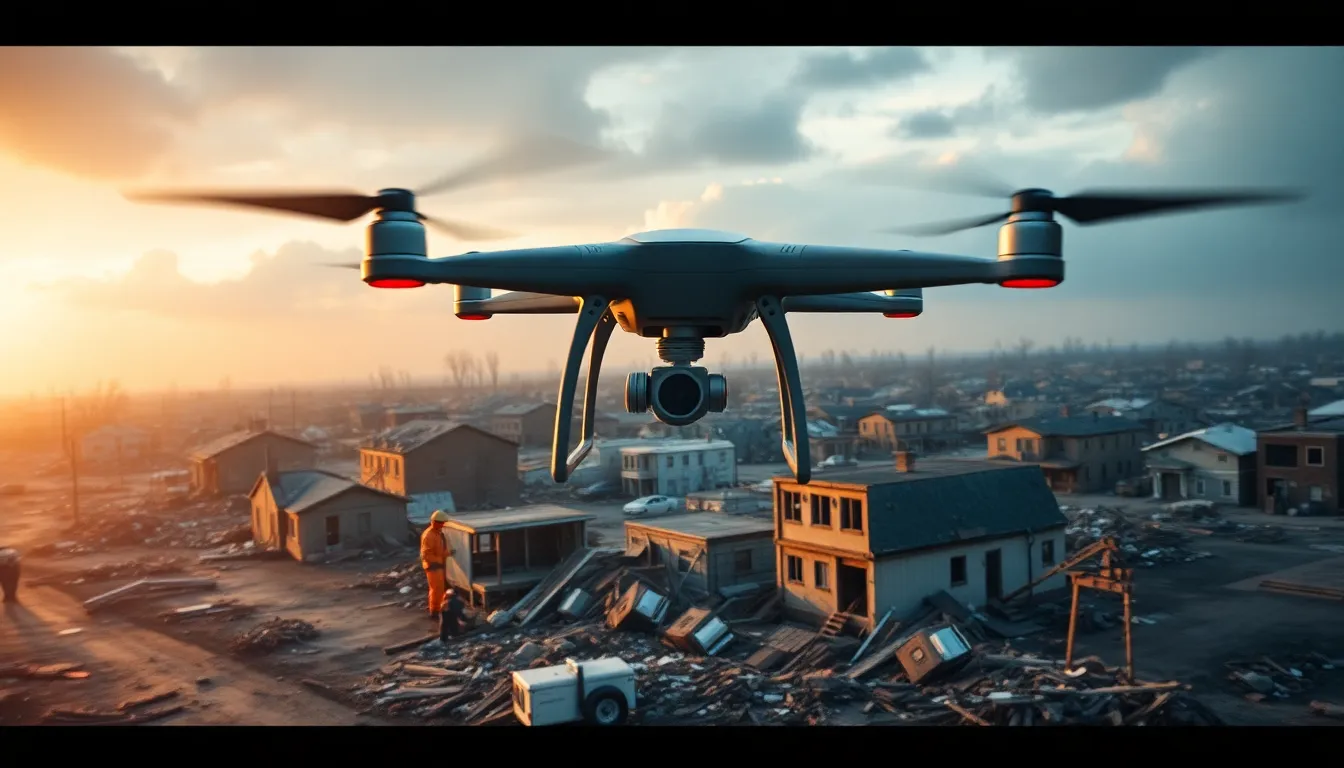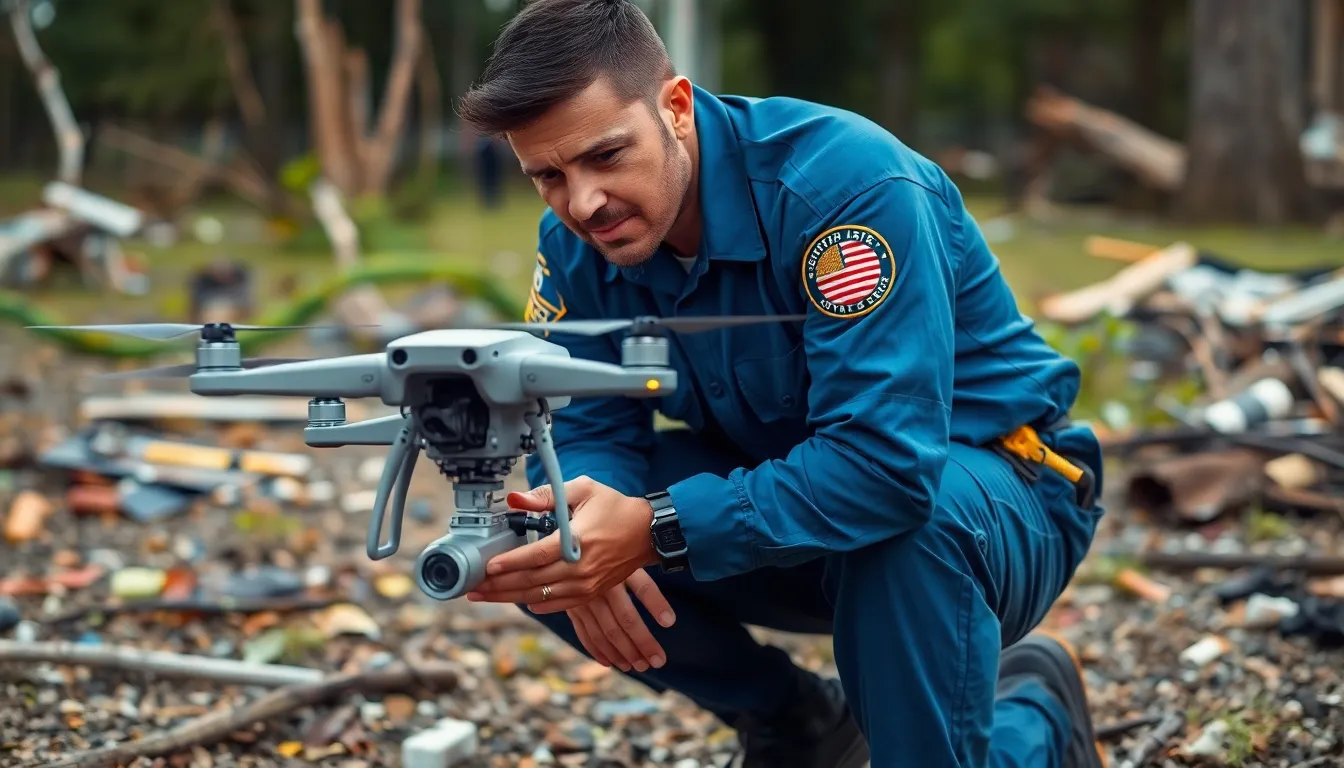Table of Contents
ToggleIn a world where superheroes are still waiting for their big break, drones are swooping in to save the day in public safety. These high-flying gadgets aren’t just for taking breathtaking selfies or delivering pizza; they’re becoming essential tools for law enforcement, emergency responders, and disaster relief teams. Imagine a drone zipping overhead, scouting for hazards or locating missing persons faster than you can say “Where’s my cape?”
Overview of Drones in Public Safety
Drones play a crucial role in enhancing public safety. Their applications span various sectors, including law enforcement, emergency response, and disaster relief.
Definition and Purpose
Drones refer to unmanned aerial vehicles that execute missions without onboard pilots. Primarily, these devices serve to provide aerial footage, locate missing individuals, and scout hazardous areas. Law enforcement agencies utilize drones for surveillance and crime scene investigations. Emergency responders often depend on them for delivering medical supplies quickly. Overall, drones offer efficiencies that improve public safety efforts significantly.
Importance in Modern Emergency Response
Drones’ impact on emergency response is significant. They provide real-time data that enhances situational awareness during crises. For instance, during natural disasters, drones assess damage and identify affected regions promptly. Emergency teams deploy drones to transport essential supplies, such as water and medication, to hard-to-reach locations. Statistics show that using drones can reduce response times by over 30%. Enhanced communication and coordination become possible as drones relay critical information to first responders. Their versatility ensures they remain an invaluable asset in modern public safety initiatives.
Applications of Drones in Public Safety

Drones play a pivotal role in enhancing public safety across various domains. These unmanned aerial vehicles offer innovative solutions for several critical applications.
Search and Rescue Operations
Search and rescue operations benefit greatly from drones. They locate missing persons quickly through thermal imaging and high-resolution cameras. Drones can cover large areas in shorter times compared to ground teams. In situations such as wilderness searches or natural disasters, these aerial devices provide real-time feedback, enabling responders to make informed decisions. Statistics show that drones reduce the time spent searching by up to 70%, significantly increasing success rates.
Disaster Response and Recovery
Drones improve disaster response and recovery efforts significantly. They assess damage after events like hurricanes or earthquakes by capturing aerial images. In prior incidents, drones enabled teams to identify hazardous zones and prioritize resource distribution effectively. Speed is crucial in disaster scenarios; thus, teams utilize drones to transport medical supplies and food to isolated areas. Reports indicate that drone involvement can cut delivery times by more than 50%, enhancing recovery operations.
Surveillance and Monitoring
Surveillance and monitoring capabilities of drones enhance situational awareness. Law enforcement agencies deploy drones for real-time surveillance in critical situations, such as hostage situations and active shooter incidents. Drones provide live video feeds, allowing responders to strategize their approach based on accurate information. Additionally, drones monitor crowds during large events, ensuring safety and compliance with regulations. Studies demonstrate that these aerial tools improve oversight efficiency, reducing risks in public safety operations.
Traffic Management
Traffic management sees significant improvements through drone applications. They monitor traffic patterns and incidents, providing live updates to traffic management centers. By surveying roads from above, drones identify congested areas and relay that information instantly. This data enables agencies to reroute vehicles effectively and reduce travel times. In urban areas, research indicates that integrating drones into traffic management can decrease congestion-related delays by 20%, contributing to smoother flows on the roads.
Advantages of Using Drones
Drones bring multiple benefits to public safety operations, enhancing efficiency and effectiveness.
Cost-Effectiveness
Cost efficiency stands out among the advantages. Drones eliminate the need for extensive manpower and equipment, reducing operational expenses significantly. Unlike traditional methods, which often require helicopters or ground vehicles, drones operate at a fraction of the cost. For instance, agencies can save up to 70% on aerial surveillance expenses. With lower maintenance costs and minimal training requirements, they allow for reallocating resources to other crucial areas. The affordability of drones makes them accessible for various public safety agencies, improving overall service delivery.
Real-Time Data Collection
Real-time data collection represents a major advantage. Drones quickly gather critical information, giving responders immediate insights during an emergency. Aerial views provide situational awareness that ground teams often lack. For example, drones can relay live video feeds and detailed imagery to command centers, shortening decision-making processes during crises. This real-time capability enhances the effectiveness of response strategies, particularly in natural disasters. Agencies utilize timely data to prioritize resources and coordinate operations more efficiently, leading to faster and more informed responses.
Enhanced Safety for Responders
Safety enhancements for responders highlight another key benefit. Drones reduce risks by taking on dangerous tasks that would typically place human lives in jeopardy. They scout hazardous areas before personnel enter, identifying potential threats. In search and rescue missions, drones can assess conditions without endangering lives, making operations safer. By minimizing the need for ground teams in risky situations, drones significantly lower accident rates among responders. This increased safety allows teams to focus on essential tasks, ultimately improving operational effectiveness during emergencies.
Challenges and Limitations
Drones in public safety face several challenges that may limit their effectiveness.
Regulatory Hurdles
Regulatory frameworks hinder drone operations in many jurisdictions. Agencies often struggle to keep up with changing regulations concerning airspace and flight permissions. Compliance with Federal Aviation Administration guidelines remains critical for law enforcement and emergency responders. Each agency must navigate different state and local laws, complicating and delaying operational deployments. The need for pilot certification adds another layer of complexity, making it harder for organizations to utilize drones effectively.
Privacy Concerns
Privacy issues present significant obstacles as well. Citizens often express concerns about surveillance and data collection practices. Drones equipped with cameras may capture sensitive information, leading to public distrust. Ensuring transparency in operations helps mitigate privacy worries and promotes community support. Departments must establish clear policies on data usage and retention to address these concerns effectively.
Technological Limitations
Technological constraints also impact the capabilities of drones. Battery life limits flight time, reducing operational range and effectiveness during extended missions. Weather conditions such as wind or rain can restrict functionality and hinder performance. Reliance on GPS signals makes drones susceptible to interference, affecting navigation precision. Furthermore, the cost of advanced technology for features like thermal imaging can be prohibitive for some agencies, limiting access to essential tools for public safety.
Future Trends in Drones for Public Safety
The evolution of drones in public safety continues to shape future operations. Technological advancements significantly enhance drone capabilities.
Advancements in Drone Technology
Enhanced flight endurance remains a key focus in drone technology. Manufacturers prioritize longer battery life, allowing multiple hours of flight time. These extended durations support complex missions like surveillance and search operations. Improved payload capacities enable drones to transport heavier equipment, including medical supplies and imaging devices. Additionally, the development of rugged designs ensures drones withstand varying weather conditions. Features like obstacle avoidance systems contribute to safety during operations. Autonomous flight capabilities also gain traction, allowing drones to execute missions without constant operator control. As these advancements emerge, public safety agencies can rely on drones for more diverse missions, increasing their overall effectiveness.
Integration with Artificial Intelligence
The integration of artificial intelligence transforms how drones are utilized in public safety. AI-powered drones enhance data analysis and decision-making processes with real-time information. Smart algorithms enable better object recognition, allowing drones to identify individuals and vehicles quickly. Additionally, real-time video analytics streamline surveillance efforts, assisting law enforcement in assessing situations rapidly. AI can also predict potential hazards by analyzing data patterns and trends. As drones become smarter, public safety teams achieve greater efficiency in their operations. Implementing AI reduces response times and empowers first responders with actionable insights. This technological synergy drives innovation in aerial support for law enforcement and emergency response efforts.
Drones are transforming public safety operations by offering innovative solutions that enhance efficiency and effectiveness. Their ability to gather real-time data and provide aerial support is invaluable during emergencies. As technology advances and regulations evolve, the potential for drones in this field will only grow.
Agencies that embrace these tools can improve response times and resource allocation while ensuring the safety of their personnel. By addressing challenges such as privacy concerns and regulatory compliance, departments can maximize the benefits of drones. The future of public safety undoubtedly includes drones as essential partners in safeguarding communities.





